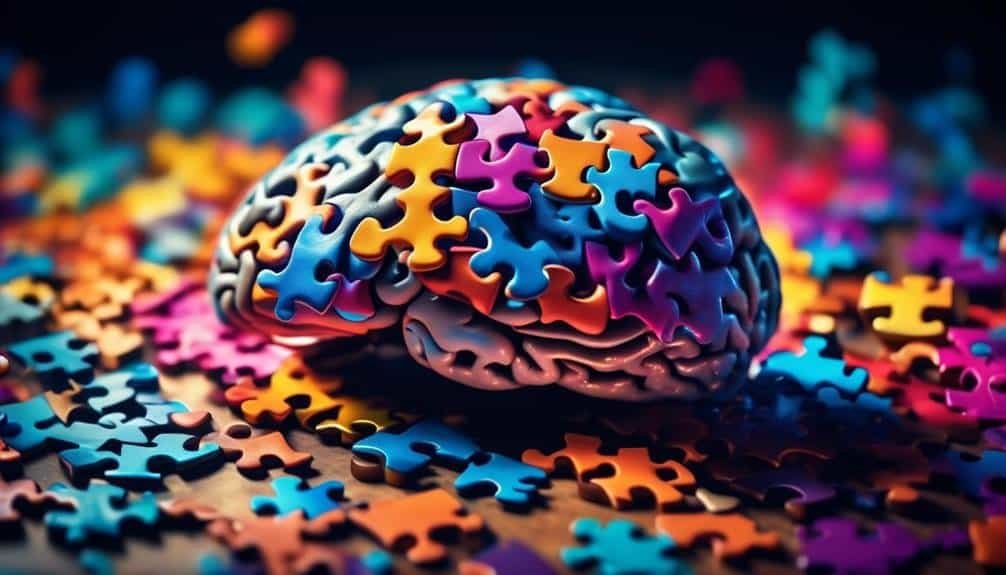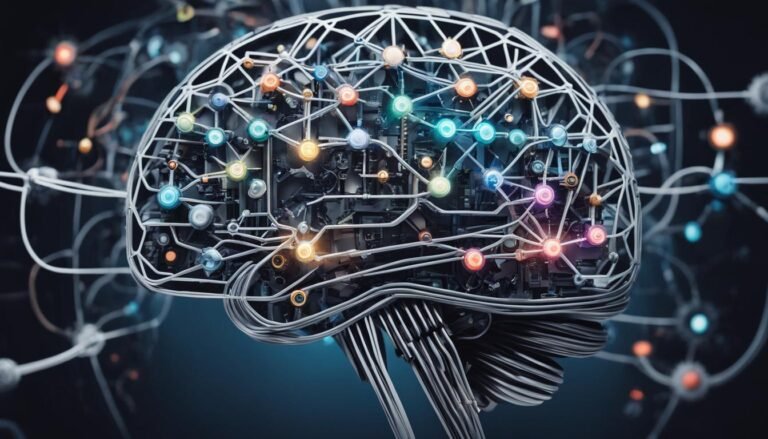Definition and Types of Neurodiversity
As you embark on the journey to understand neurodiversity, consider it a mosaic, with each piece representing a unique variation in the human brain.
You’ll find that neurodiversity encompasses a spectrum of neurological differences, acknowledged and respected for their contributions to the rich tapestry of human cognition.
It’s not just about recognizing conditions like Autism Spectrum Disorder, Attention Deficit Hyperactivity Disorder, or Dyslexia, but also appreciating the nuanced ways in which these differences manifest in individuals.
While you grasp the contours of this concept, you’ll see how the conversation has shifted from one of deficit and disorder to that of variation and strength.
Stay with this exploration to uncover how these diverse neurological makeups challenge conventional thinking and offer fresh perspectives in various realms of society, including the workplace.
Key Takeaways
- Neurodiversity encompasses natural neurological variations in the human population.
- Conditions like autism, ADHD, dyslexia, and Tourette’s Syndrome fall under the neurodiverse umbrella.
- The historical perspective of neurodiversity has shifted from pathologizing to valuing neurological differences.
- Inclusive education is a critical concept within neurodiversity, accommodating and valuing varied neurological constitutions.
Understanding Neurodiversity
To grasp the concept of neurodiversity, it’s essential to recognize that it encompasses a spectrum of neurological variations that are natural and intrinsic to the human population. These variations manifest in diverse cognitive functioning and behavioral traits, which contribute to the broader notion of cognitive diversity. This term implies an array of mental processes and perspectives that diverge from what’s typically deemed standard or normal.
In an analytical context, you’ll find that neurodiversity includes, but isn’t limited to, autism, ADHD, dyslexia, and Tourette’s Syndrome, each carrying distinct attributes yet unifying under the neurodiverse umbrella. The technical approach to neurodiversity examines the genetic, developmental, and environmental factors contributing to these neurological differences.
Delving into the details, inclusive education emerges as a critical concept within neurodiversity. It advocates for educational systems to accommodate and value varied neurological constitutions. An inclusive educational framework doesn’t merely integrate neurodiverse individuals but also tailors teaching methodologies, assessments, and learning environments to harness the unique cognitive strengths and address the challenges presented by neurodivergent learners. This strategy underscores the importance of adopting a neurodiversity-affirming perspective, one that fosters an environment where neurological differences aren’t just accepted but celebrated.
Historical Perspective
Examining the historical perspective of neurodiversity reveals a shift from pathologizing neurological differences to recognizing and valuing them as a natural human variation. Initially, cultural perceptions were steeped in medical models that viewed conditions like autism, ADHD, and dyslexia as deficits requiring treatment or cure. This perspective predominated throughout much of the 20th century, where the focus was on the ‘disorder’ and ‘impairment’ aspects of neurodivergent individuals.
However, the late 1990s marked the onset of advocacy evolution. Spearheaded by sociologists and activists within the autistic community, the neurodiversity movement began to gain traction. It argued for a paradigm shift – one that understands neurological differences as part of the normal variance in the human genome, rather than as pathologies. This reconceptualization embraced the idea that all neurocognitive functioning styles have merit and contribute to the rich fabric of society.
You’ll observe that with the rise of the neurodiversity movement, there’s been an increase in inclusive educational practices, employment initiatives, and a broader societal push towards acceptance and accommodation. The historical lens thus captures a transformative journey from a deficit-focused view to a celebration of cognitive diversity, profoundly impacting cultural perceptions and the lives of neurodivergent individuals.
Autism Spectrum Disorder
As you explore Autism Spectrum Disorder (ASD), you’ll find it’s a complex developmental condition marked by a range of challenges in social interaction, communication, and repetitive behaviors.
You must recognize the spectrum’s breadth, as behavioral characteristics can vary significantly from one individual to another, necessitating personalized therapeutic intervention strategies.
Analyzing these interventions, you’ll note that they’re grounded in evidence-based practices tailored to improve the quality of life and functional independence of those with ASD.
Understanding Autism Spectrum
Autism Spectrum Disorder (ASD) is a complex neurodevelopmental condition characterized by a range of symptoms and abilities that manifest uniquely in each individual. You’ll find that autism misconceptions often oversimplify or misrepresent the condition, failing to acknowledge the diverse experiences of those on the spectrum. Overcoming communication barriers is a critical aspect of understanding ASD, as these can significantly impact social interaction and personal expression.
| Aspect | Detail |
|---|---|
| Social Interaction | Individuals may have challenges with social cues and may not interact in typical ways. |
| Communication | There may be difficulties with verbal and non-verbal communication, often misunderstood. |
| Behavioral Patterns | Repetitive behaviors and strict adherence to routines are common and vary in intensity. |
An analytical approach to ASD requires recognizing these complexities and the individualized nature of the condition.
Behavioral Characteristics
Building on the individualized nature of ASD, it’s crucial to explore the specific behavioral characteristics that often define the condition. These manifestations are linked to the unique cognitive patterns and social interactions that individuals with ASD experience. By breaking down these characteristics, you’ll gain a clearer understanding of how ASD may present itself:
- Repetitive Behaviors: Engaging in repetitive motions or rituals that provide comfort or manage sensory input.
- Challenges in Social Interactions: Difficulties in interpreting social cues, leading to potential misunderstandings or social withdrawal.
- Intense Focus on Interests: Deep, pervasive interest in specific topics, often coupled with an impressive depth of knowledge.
- Sensory Sensitivities: Over- or under-reaction to sensory stimuli, affecting daily functioning.
- Communication Variabilities: A wide range of verbal abilities, from nonverbal communication to advanced vocabulary, often with a preference for direct, literal speech.
Therapeutic Interventions Strategies
Understanding the range of therapeutic interventions available for Autism Spectrum Disorder (ASD) is essential for tailoring treatment to each individual’s needs, encompassing techniques from behavioral therapies to communication and social skills training. Cognitive behavioral therapy (CBT) is particularly noteworthy for its structured approach to modifying thought patterns, thereby influencing behavior in a positive manner. Alongside CBT, mindfulness practices are gaining traction, aiding in anxiety reduction and improving focus.
To give you a clearer picture, consider the following table:
| Intervention Type | Key Components | Expected Outcomes |
|---|---|---|
| Behavioral Therapies | Reinforcement, modeling | Improved social behaviors, functional skills |
| Cognitive Behavioral Therapy | Identification of thoughts, cognitive restructuring | Enhanced emotional regulation, reduced anxiety |
| Mindfulness Practices | Breathing exercises, meditation | Increased focus, stress management |
These strategies, when analytically applied, can foster significant improvements in daily living and interpersonal interactions.
Attention Deficit Hyperactivity Disorder
As you explore Attention Deficit Hyperactivity Disorder (ADHD), you’ll encounter specific diagnostic criteria that clinicians use to identify the condition, including a persistent pattern of inattention and/or hyperactivity-impulsivity.
Understanding how individuals manage ADHD symptoms is crucial, with strategies ranging from medication to behavioral interventions.
The disorder’s impact on daily life spans various domains, affecting academic performance, occupational success, and interpersonal relationships.
ADHD Diagnostic Criteria
What specific criteria must clinicians follow when diagnosing Attention Deficit Hyperactivity Disorder (ADHD) in individuals? Considering ADHD prevalence, neurobiological research has significantly informed the diagnostic criteria, aiming to ensure accurate identification and support.
The following list delineates the critical elements for diagnosis:
- Age of Onset: Symptoms must be present before the age of 12.
- Duration: Symptoms persist for at least 6 months.
- Context: Symptoms are apparent in two or more settings (e.g., home, school).
- Impairment: Symptoms interfere with, or reduce the quality of, social, academic, or occupational functioning.
- Exclusion of Other Disorders: Symptoms aren’t better explained by another mental disorder.
Clinicians must meticulously analyze these criteria, as ADHD’s impact on an individual’s daily functioning is profound and necessitates a tailored approach to intervention.
Managing ADHD Symptoms
Effective management of ADHD symptoms requires a multifaceted approach that combines medication, behavioral therapies, and lifestyle adjustments tailored to each individual’s unique needs.
Stimulant medications, such as methylphenidate and amphetamines, are often first-line treatments, enhancing neurotransmitter activity to improve focus and reduce impulsivity.
Concurrently, behavioral interventions like cognitive-behavioral therapy (CBT) address negative thought patterns, fostering self-regulation skills.
ADHD coaching emerges as an instrumental resource, providing structured support in organizing tasks and setting attainable goals. It emphasizes time management strategies, crucial for mitigating procrastination and enhancing productivity.
Additionally, lifestyle changes, including regular exercise and sleep hygiene, contribute significantly to symptom control.
Collectively, these strategies establish a comprehensive framework for managing ADHD, promoting functional improvements across various life domains.
ADHD’s Impact on Life
ADHD significantly disrupts daily life, with its symptoms often leading to challenges in academic achievement, workplace performance, and social interactions. Here’s a detailed look at its impact:
- Academic Difficulties: Struggles with focus and impulsivity can result in lower grades and educational attainment.
- Workplace Challenges: ADHD may cause issues with time management, organization, and meeting deadlines, affecting career progression.
- Social Complications: Difficulty in maintaining attention in conversations can lead to misunderstandings and strained relationships.
- Emotional Regulation: Managing emotions may be harder, increasing the risk of anxiety and depression.
- Productivity Strategies: Implementing ADHD coping mechanisms such as structured routines and prioritization techniques can mitigate some disruptions.
Understanding these impacts is crucial for developing effective ADHD coping strategies and enhancing overall productivity and quality of life.
Dyslexia and Learning Differences
Dyslexia, a common learning difference, impacts an individual’s ability to process written language, often leading to challenges in reading, writing, and spelling. You’ll find that understanding dyslexia requires recognizing the individual experiences and needs of those affected. To support your journey through academia, reading strategies and academic accommodations are essential tools. These may include extra time on tests, the use of text-to-speech software, and alternative assessment methods.
Given the complexity of dyslexia, it’s crucial to examine its characteristics and interventions in a structured way. Below is a table offering a concise overview:
| Characteristic | Intervention |
|---|---|
| Difficulty with phonological processing | Phonics-based reading programs |
| Slow reading speed | Extended time for reading tasks |
| Problems with reading comprehension | Explicit teaching of comprehension strategies |
| Difficulty with spelling and writing | Access to word processors with spell-check |
As seen in the table, interventions are tailored to address specific difficulties. Phonics-based programs, for example, focus on the relationship between letters and sounds, a foundational skill for reading. Extended time for reading tasks, comprehension strategy instruction, and the use of technology are all academic accommodations that level the playing field, allowing you to engage with material in ways that play to your strengths.
Sensory Processing Disorder
While personalized interventions help individuals with dyslexia navigate academic challenges, those with Sensory Processing Disorder (SPD) require strategies tailored to manage their unique sensory experiences. SPD involves disruptions in sensory integration, the neurological process that organizes sensation from one’s own body and the environment, making it possible to use the body effectively within the environment. Individuals with SPD may have difficulty modulating, discriminating, or organizing sensory input, which can often lead to behavioral and emotional issues, as well as challenges in performing everyday tasks.
Your understanding of SPD is enhanced by delving into the concept of neurological thresholds. These thresholds define the amount of sensory input required for the nervous system to react. Individuals with SPD may possess atypical neurological thresholds, resulting in hyper- or hypo-sensitive responses to sensory stimuli. Consider the following aspects:
- Sensory Over-Responsivity: Overwhelming responses to stimuli that are typically non-irritating.
- Sensory Under-Responsivity: Lack of reaction to sensory inputs that would normally elicit a response.
- Sensory Craving: An insatiable desire for sensory experiences.
- Sensory Discrimination Disorder: Difficulty in distinguishing between different sensory inputs.
- Sensory-Based Motor Disorder: Challenges with balance, motor coordination, or positional awareness due to unreliable sensory feedback.
Addressing SPD requires a nuanced approach that respects the individual’s sensory preferences and threshold levels.
Intellectual and Developmental Diversity
Intellectual and developmental diversity encompasses a broad range of cognitive abilities and neurological variances that shape how individuals perceive, interact with, and navigate the world around them. This concept recognizes that cognitive variability is natural and significant within the human population, and it impacts learning, problem-solving, attention, and memory.
Diverse intelligences reflect the multitude of ways that people understand and engage with information. For instance, someone with dyslexia may struggle with traditional reading and writing but excel in complex spatial reasoning or creative problem-solving. Similarly, an individual with autism might display remarkable talents in pattern recognition or possess a deep understanding of a specialized topic, yet find social interactions challenging.
When discussing intellectual and developmental diversity, it’s essential to consider both the strengths and challenges unique to each neurotype. Educational and occupational environments must adapt to accommodate these differences, emphasizing inclusive practices that allow for multiple pathways to learning and achievement.
Neurodiversity in the Workplace
Embracing neurodiversity in the workplace requires organizations to implement inclusive hiring practices and adaptive work environments that cater to the varied cognitive profiles of their employees. Inclusive hiring ensures that recruitment processes accommodate neurodiverse individuals, often involving adjustments to interview techniques and job requirements.
Meanwhile, workplace accommodations are modifications or adjustments to the job or work environment that enable neurodiverse employees to perform their job duties effectively.
Here are key strategies to consider:
- Utilize structured interview processes with clear, predictable formats.
- Provide written job offers and descriptions with explicit expectations.
- Implement flexible scheduling to accommodate various neurological needs.
- Design quiet workspaces or provide noise-cancellation devices to reduce sensory overload.
- Offer ongoing support through mentorship programs or neurodiversity training for staff.
An analytical examination of neurodiversity in the workplace reveals that businesses benefit from the unique perspectives and skills of neurodiverse individuals. Technical roles, for instance, may be enriched by the pattern recognition abilities often found in autistic individuals. Detailed-oriented tasks might be well-suited to those with attention-deficit/hyperactivity disorder (ADHD), who can hyper-focus under the right conditions.
Conclusion
In sum, you’ve navigated the intricate landscape of neurodiversity, as varied and complex as a tapestry woven with countless unique threads.
Each condition, from Autism Spectrum Disorder to Sensory Processing Disorder, offers a distinct pattern of thought and interaction.
In the workplace, embracing this diversity isn’t just ethical; it’s strategic, harnessing a spectrum of cognitive abilities that can drive innovation and progress.
Acknowledge and integrate these differences, and you’ll see the strength in every thread of the human cognitive fabric.







